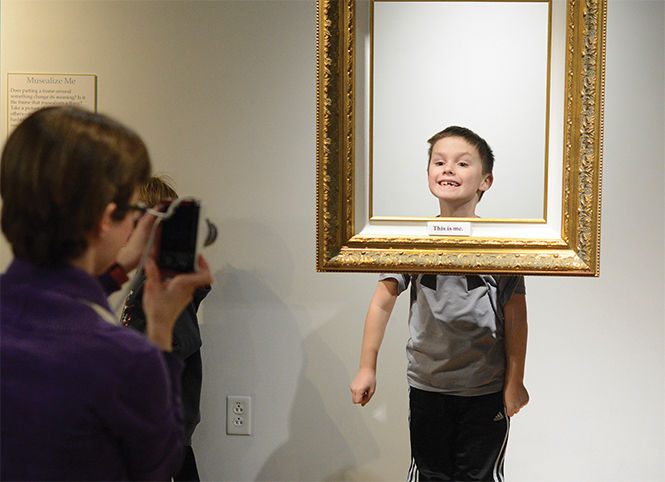KSU faculty member curates “Museality” exhibit in the SLIS MuseLab
Max Kenworthy, age 7 from Kent, jumps into the air to get his head into an empty frame hanging in the new MuseLab art gallery in the School of Library and Information Science after putting the tag “this is me” on the frame Wednesday, Jan. 28, 2014.
January 28, 2015
The Kent State University School of Library and Information Science’s newest exhibit, “Museality,” focuses on the research surrounding human relationship with physical objects presented in the University Library.
Kiersten Latham, an assistant professor in the school of library and information science and the curator of the exhibit, said the theme of “Museality” is to spark questions to the viewers.
The exhibit is intended to be the signature installation that explores the core mission of the MuseLab — a creative and collaborative space for thinking, doing and learning about museal things, according to a Kent State press release.
SLIS hosted a reception for the exhibit in the MuseLab on Wednesday, Jan 28 that was open to the public.
Latham said she hopes those who visit will ask themselves questions relevant to objects in a museum.
“The idea is to explore what happens when an object or a document comes into a museum,” Latham said. “How does it change? What makes it different? The whole idea is to play around with that idea, that context, where an object is in space and time, and how it changes when it is moved around a museum.”
One of the museum studies classes that Latham teaches is designed to have students work on the exhibits in the MuseLab. Her students work on the content, design and other details that deal with each exhibit that goes into the lab.
Corina Iannaggi, a graduate appointee in the school of library science, helped with fabrication and printing of the texts for the exhibit.
“Even though you will think it is a relatively simple exhibit, it still is a lot of work to put it all together,” Iannaggi said.
She and the students used a 44-inch wide format printer, vinyl cutter and dry mounter to help set up the texts for the exhibit. After the texts are cut to the size and shape they want, it is mounted onto foam board to give it a professional look.
Students also used software called SketchUP, which allowed them to look at the exhibit as a 3D model and let them tweak things easily until they arrived at the look they wanted.
Latham said she hopes this exhibit intrigues people to wonder how context changes a person’s view on an object. For example, if a student had a frame, lighting, mount or a certain set up why might that change the way you look at the content?
One feature in the exhibit is “Musealize Me,” which is a free-hanging empty picture frame. The purpose, Latham said, is to have people take pictures of themselves in the frame and add a label that represents them. This element is to show how people associate art with frames.
Latham said she hopes “Musealize Me” will spark questions such as: Does a frame make something “art”? How does a frame change the way you look at the content?
Also displayed in the exhibit is a case with red ruby shoes in it that was lit, mounted and displayed professionally. The question Latham and her students hope people will wonder is “why are the shoes in there?” and “what is so special about them?”
A blank wall inside the exhibit was designed for people to leave their thoughts and answers to the many questions this exhibit brings to mind.
Andrea Wittmer, a graduate student in the College of Communication and Information, said she put together a promotional case for the second floor of the library for the exhibit. She started worked on this promotional tool for over two months.
“A lot of it depends on how it’s presented to you, as the viewer,” Wittmer said. “It all depends on what you bring to the exhibit, as much as what the exhibit is on its own.”
“Museality” marks the first exhibit in the MuseLab that was curated by a faculty member since the opening in the fall of 2013.
It is also the first MuseLab project involving extensive collaboration outside of the university. Partners who helped donate actual artifacts ranging from art to science to history were needed in order to explore the concept of museality. Those partners included the Kent Historical Society Museum, Cummings Center for the History of Psychology, as well as Kent State School of Art Galleries and community members according a Kent State University press release.
The gallery is open to visitors Monday through Friday from 8 a.m. to 5 p.m.
Contact Nick Boone at [email protected].

























